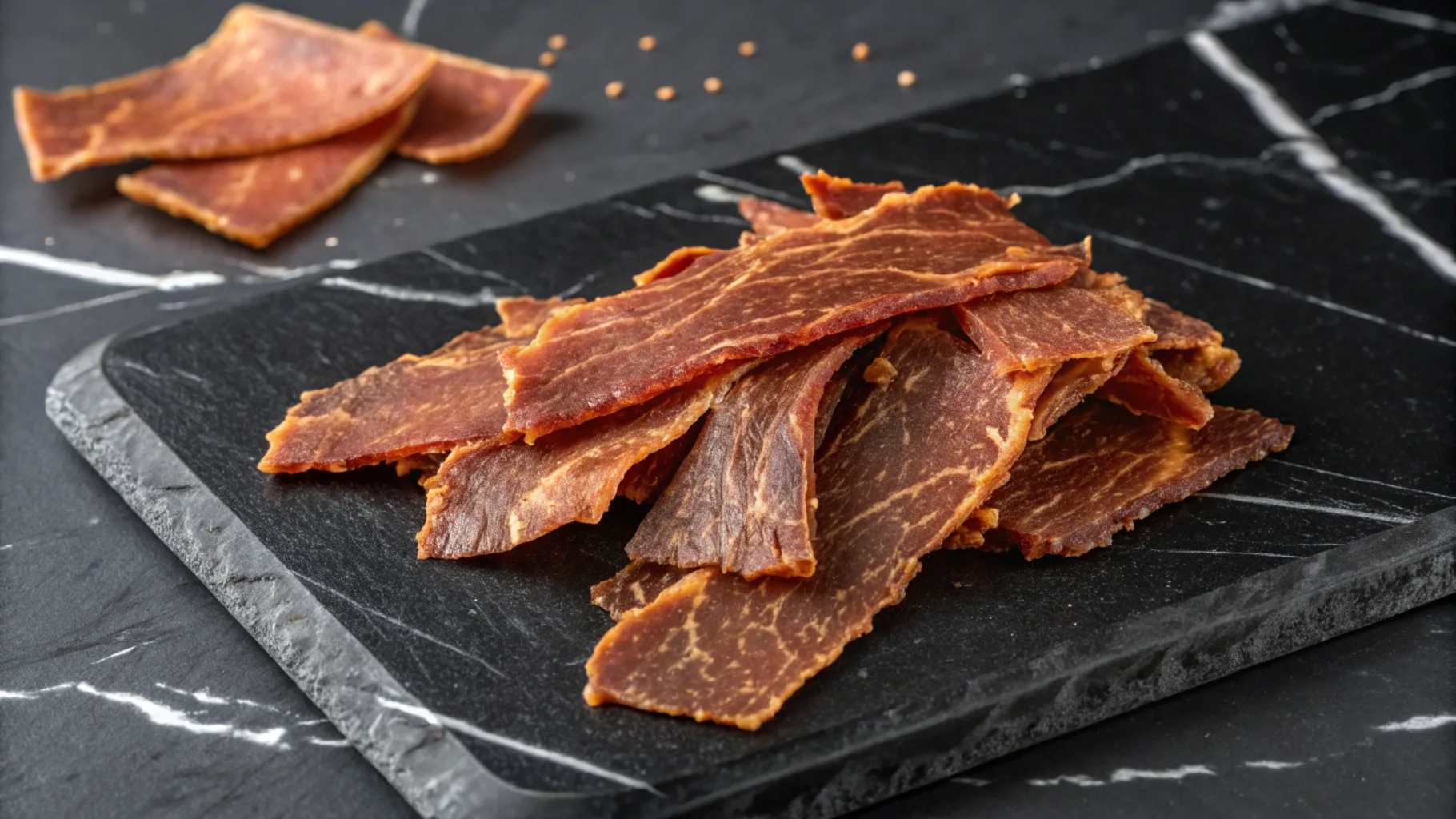Chicken jerky is a high-protein snack that has gained popularity for its lean nutrition profile and convenient preparation. Whether you’re looking for a quick, portable snack or a healthy dog treat, chicken jerky is versatile and easy to prepare. This guide will walk you through everything you need to know—from preparation to storage tips and flavor variations.

Why Choose Chicken Jerky?
1. Nutritional Benefits of Chicken Jerky
Chicken jerky is a nutrient-dense snack that offers a range of health benefits, making it a top choice for individuals focused on fitness and healthy eating.
- High in protein and low in fat, it supports muscle recovery and weight loss diets by keeping you full for longer periods.
- It is packed with essential amino acids, which are vital for muscle growth, tissue repair, and immune system support.
- Rich in vitamins like B6 and minerals such as phosphorus and selenium, it contributes to energy production and bone health.
- Compared to beef jerky, chicken jerky is lower in calories and easier to digest, making it an excellent option for low-fat and low-calorie diets.
For more protein-packed meal ideas, check out this Protein Baked Oatmeal recipe, which pairs well with chicken jerky as part of a balanced, high-protein diet.
2. Versatile Uses for Chicken Jerky
Chicken jerky is not just a snack—it’s a multi-purpose ingredient that fits into various dietary needs and meal plans:
- Perfect for meal prepping—its long shelf life makes it a reliable protein source for busy schedules, road trips, and outdoor activities like hiking or camping.
- A great post-workout snack, providing a quick protein boost to refuel muscles after intense activity.
- Can be customized into pet-friendly jerky with fewer seasonings, offering a natural, healthy treat for dogs.
- Ideal as an ingredient for salads, wraps, and protein bowls, or served as a crunchy topping for dishes like Crispy Chicken Salad to add texture and flavor.
- It complements low-carb or keto diets when paired with vegetables, cheeses, and nuts, making it versatile for diet-conscious individuals.
Whether you’re a fitness enthusiast, busy professional, or pet owner, chicken jerky adapts easily to your lifestyle, offering a healthy, portable, and flavorful option.
Step-by-Step Guide to Making Chicken Jerky
1. Selecting the Best Chicken Cuts
Choosing the right chicken cut is crucial for making high-quality chicken jerky.
- Boneless, skinless chicken breasts are the best option because they are lean, easy to slice, and have a lower fat content, which helps prevent spoilage during storage.
- Avoid chicken thighs or drumsticks as they
- contain more fat, which can lead to rancidity over time and shorten the jerky’s shelf life.
Trim off any visible fat or connective tissue before slicing to further reduce the risk of spoilage.
2. Slicing and Marinating
Proper slicing and marination are essential for achieving consistent flavor and texture in chicken jerky.
Slicing Tips:
- Freeze the chicken for about 1 hour before slicing—this makes it easier to cut uniform strips.
- Use a sharp knife to cut strips that are approximately 1/8 to 1/4 inch thick.
- Slice against the grain for tender jerky or with the grain for a chewier texture.
Marinade Options:
Marinades add flavor and preserve the meat. Here are some popular options:
- Classic Teriyaki: Soy sauce, honey, garlic, and ginger for a sweet and savory flavor.
- Spicy Cajun: Chili flakes, smoked paprika, and liquid smoke for a bold, smoky kick.
- Sweet Maple Glaze: Inspired by the Baked Maple Salmon recipe, this marinade uses maple syrup, soy sauce, and mustard for a sweet and tangy twist.
Marinating Tips:
- Let the chicken strips soak in the marinade for at least 6–24 hours in the refrigerator.
- Use ziplock bags or airtight containers to ensure the chicken is evenly coated.
- Rotate or shake the bag periodically to distribute flavors evenly.
3. Preserving with Curing Salt (Optional)
For added safety and preservation, consider using curing salt:
- Curing salt prevents bacterial growth, including Salmonella and E. coli, which is especially important for poultry.
- Use it sparingly—typically 1/4 teaspoon per pound of meat.
- It also helps retain the jerky’s color and texture while extending its shelf life.
For detailed safety guidelines, refer to the USDA Food Safety Guidelines to ensure your jerky is prepared under safe conditions.
By selecting the best cuts, using flavorful marinades, and following safety practices, you can create delicious, long-lasting chicken jerky that’s perfect for snacking, meal prep, or even pet treats!
3. Drying Techniques
Dehydrator Method
- Set to 165°F for 4–6 hours.
- Arrange strips in a single layer with space between them for airflow.
Oven Method
- Preheat oven to 200°F and bake for 4–5 hours on racks over baking sheets.
- Check readiness using the bend or rip test—jerky should bend without breaking.
Smoker Method
- Smoke with applewood or hickory chips at 165°F for 3–4 hours for a rich flavor.
Storage Tips for Chicken Jerky
Short-Term Storage (1–2 Weeks)
- Store chicken jerky in airtight containers at room temperature for 1–2 weeks.
- Keep it in a cool, dry place, away from sunlight and moisture.
- Use vacuum-sealed bags for added freshness.
Medium-Term Storage (Up to 4 Weeks)
- Refrigerate in sealed containers or vacuum-sealed bags for up to 4 weeks.
- Label with the date of preparation to track freshness.
Long-Term Storage (Up to 6 Months)
- Freeze in airtight, freezer-safe bags for up to 6 months.
- Vacuum-seal to prevent freezer burn and maintain flavor.
- Thaw at room temperature before eating.
Travel Tips
- Pack in single-serving bags for hiking or meal prepping.
- Pair with dishes like Hashbrown Casserole for a hearty meal.
Check for Spoilage
- Watch for off smells, mold, or a sticky texture—discard if unsure.
Proper storage ensures chicken jerky stays fresh, safe, and delicious for weeks or even months!
Chicken Jerky Variations for Pets
Chicken jerky isn’t just a healthy snack for humans—it can also be a nutritious treat for pets when prepared properly. Follow these tips to make pet-safe chicken jerky that’s free from harmful ingredients and packed with flavor.

Pet-Safe Ingredients and Marinades
- Plain Chicken Strips: Use boneless, skinless chicken breasts with no seasoning for a simple, protein-rich treat.
- Honey-Based Marinades: Add a touch of honey or apple cider vinegar for flavor and natural preservation.
- Apple Cider Vinegar: Replace curing salt with this natural preservative to prevent spoilage while keeping it safe for pets.
- Optional Additions: Lightly sprinkle turmeric or parsley for added anti-inflammatory and digestive benefits—but always check with your vet first.
Dehydration Process
- Temperature: Dehydrate at 165°F to ensure the chicken is cooked thoroughly and bacteria-free.
- Texture Check: Jerky should be firm and dry but still chewy—avoid over-drying to keep it easy for pets to chew.
- Cooling Time: Allow jerky to cool completely before serving or storing to prevent moisture buildup.
Portion Sizes for Pets
- Cut jerky into bite-sized pieces for smaller dogs or cats.
- Larger strips can be served to big breeds or used as training rewards.
- Adjust portions based on your pet’s size, age, and dietary needs.
Storage Tips for Pet Jerky
- Store in airtight containers or vacuum-sealed bags to maintain freshness.
- Refrigerate for up to 2 weeks or freeze for longer storage (up to 3 months).
- Always label containers with the date of preparation and check for spoiling before serving.
Safety Notes for Pet Jerky
- Avoid spices, garlic, onions, and excessive salt, as they are toxic to pets.
- Introduce jerky slowly into your pet’s diet to check for allergic reactions or digestive issues.
- Consult your veterinarian before adding homemade treats to your pet’s diet, especially if they have dietary restrictions or health conditions.
By using natural ingredients and following safe preparation methods, you can create a healthy, homemade chicken jerky treat that your pets will love!
FAQs About Chicken Jerky
1. Is Chicken Jerky Safe to Eat?
Yes, chicken jerky is safe to eat as long as it is cooked to an internal temperature of 165°F during dehydration. This temperature ensures that harmful bacteria like Salmonella are eliminated.
For added safety and longer shelf life, you can include curing salt in the marinade, which helps inhibit bacterial growth and acts as a preservative.
2. How Long Does Chicken Jerky Last?
- Room Temperature: Store in airtight containers for 1–2 weeks.
- Refrigerated: Keeps fresh for 3–4 weeks when properly sealed.
- Frozen: Stays good for up to 6 months if stored in vacuum-sealed bags or freezer-safe containers.
Always check for spoilage—look for off smells, mold, or a sticky texture before consuming.
3. Can Chicken Jerky Be Made Without a Dehydrator?
Absolutely! Chicken jerky can be made in an oven set at 200°F:
- Arrange chicken strips on wire racks over baking sheets to allow airflow.
- Bake for 4–5 hours, checking regularly to prevent overdrying.
- Test doneness using the bend or rip test—jerky should crack but not snap.
While a dehydrator is often more efficient, an oven is a great alternative for home cooks.
4. Is Chicken Jerky Suitable for Dogs?
Yes! Chicken jerky can be a healthy treat for dogs when prepared properly.
- Use plain chicken strips with no spices, garlic, onions, or excessive salt, which can be toxic to pets.
- Opt for mild marinades, such as those using honey or apple cider vinegar, to add flavor without risking your dog’s health.
- Cut into bite-sized pieces for small dogs or larger strips for bigger breeds.
Always monitor your pet’s reaction after introducing jerky and consult your veterinarian if you’re unsure about dietary compatibility.
Final Tips for Perfect Chicken Jerky
- Experiment with flavor marinades like spicy, sweet, or savory profiles.
- Pair chicken jerky with dishes like Chicken Apple Sausage for a balanced meal.
- Store properly to ensure long shelf life and maximum flavor retention.
Whether you’re preparing chicken jerky for personal snacking, adding it to salads, or making pet-friendly treats, this guide equips you with everything you need to get started. Try it today and enjoy a healthy, flavorful snack anytime!


